 |
 |
 |
 |
 |
 |
 |
|
 |
|
  |
|
|
|
 |
 |
- Days of spaceflight: 1127
- Days of Solar Wind Collection:
884
- Total distance traveled from launch
to Earth return: ~32 million kilometers (20 million
miles)
Relative to the Sun, Genesis traveled ~1.8 billion
miles, essentially the motion of the Earth about the
Sun for 1127 days
- Sample material collected: ~1020 Ions, ~0.4 milligrams
|
|
|
Not since
the days of Apollo have NASA navigators performed course
plotting designed to bring a spacecraft from beyond
Earth's orbit to a predestined landing zone on Earth.
To do so, the Genesis navigation team calls upon the
giant dishes of NASA's Deep Space Network to provide
data on the Genesis trajectory. Navigators analyze the
spacecraft's radio signal using techniques called radiometric
and Doppler tracking to help pinpoint its distance from
Earth as an aid to navigation.
Throughout the Genesis mission, tracking and telecommunications
have been provided by NASA's Deep Space Network complexes
in California, Australia and Spain. The data rate from
the spacecraft ranges from 1 to 47 kilobits per second.
The Deep Space Network receives most data from
the spacecraft through 34-meter-diameter (110-foot) antennas,
but 26-meter (85-foot) antennas have also occasionally
been used.
 |
 |
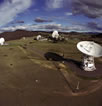 |
 |
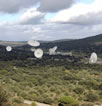 |
| 70-meter (230 ft) at Goldstone Complex, California |
|
View of the Canberra Complex, Australia showing the 70-meter (230 ft) antenna and the 34-meter (11 ft) antennas |
|
Overview of the entire Madrid Antenna Complex, Madrid, Spain |
|
|
 |
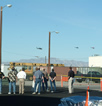 |
 |
| |
Members of the Recovery Team watch as OSCAR and Vertigo Helicopters leave hanger to intercept capsule |
|
The Utah Test & Training Range provides the largest
overland contiguous block of restricted airspace in
the continental United States authorized for supersonic
flight, available for aircrew training and weapons testing.
The airspace, situated over 6,796 square kilometers
(2,624 square miles), is under the jurisdiction of the
U.S. Air Force. The remainder is managed by the U.S.
Army at Dugway Proving Ground. Airspace boundaries do
not necessarily coincide with the boundaries of the
Defense Department land beneath the airspace.
Operated and maintained by the 388th Range Squadron
based out of Hill Air Force Base some 50 miles to the
east, the Utah Test & Training Range supports training
numerous branches of the armed services and their allies
with capabilities for air-to ground, air-to-air and
ground force exercises. More than 22,000 training sorties
and more than 1,000 test sorties are flown out on the
range annually. It is used for testing munitions and
propellants up to the most powerful ICBM rocket motors
and non-nuclear explosive components.
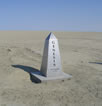 |
 |
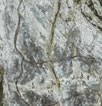 |
| Monument purchased and designed by Genesis team members to commemorate the return to Earth |
|
View from space of the Utah Test and Training Range post return |
|
The Air Force range is supporting Genesis by providing
range imagery and targeting guidance. The range's mission
control center — located at Hill Air Force Base — will radio information to the helicopter crews.
An Air Force building at the Army's Michael Army Air
Field will be home to the clean room erected to temporarily
house the Genesis capsule after it is captured.
|
|
|
The U.S.
Army's Dugway Proving Ground serves as the nation's
chemical and biological defense proving ground. It is
a large, remote, high-desert closed post that employs
about 1,200 military, government civilians and support
contractors. The mission of Dugway Proving Ground is
to test U.S. and allied biological and chemical defense
systems; perform nuclear-biological-chemical survivable
testing of defense material; provide support to chemical
and biological weapons conventions; and operate and
maintain an installation to support test missions.
Dugway is supporting Genesis by providing facilities,
logistical, weather and range expertise as well as security
and support personnel. The majority of the events surrounding
the Genesis capture and return will occur at the facility's
Ditto Test Area which approximately 19 kilometers (12
miles) from the installations main gate. Located in
Ditto is the Michael Army Air Field, where the Genesis
recovery helicopters will be based. Dugway is located
approximately 130 kilometers (about 80 miles) west-southwest
of Salt Lake City, in the Great Salt Lake Desert in
Tooele County, Utah. The Dugway Proving Ground covers
3,233 square kilometers (1,248 square miles) —
larger than the state of Rhode Island. Surrounded on
three sides by mountain ranges, the proving ground's
terrain includes mountains, valleys and a large, flat,
sparsely vegetated area that extends westward into the
southern reaches of expansive salt flats of the Great
Salt Lake Desert.
|
|
Fact sheets are short informative
texts with graphics or photos that provide specific
information without the expectation of action on the
part of the reader. They are available on a variety
of topics from Genesis mission outreach. Each individual
fact sheet deals with a narrow topic. These are further
organized as sets about the Genesis mission, about the
Genesis spacecraft, and about different disciplines
in science.
The Portable Document Format (PDF)
is used to distribute fully formatted, print-quality
documents electronically. The following information
is available to view and print as a PDF file with Adobe's
Acrobat reader.
|
|
|
Genesis is sponsored by NASA's Discovery Program, which competitively selects lowcost solar system exploration missions with highly focused science goals. The Jet Propulsion Laboratory, Pasadena, Calif., manages the Genesis mission for NASA's Office of Space Science, Washington, D.C. Lockheed Martin Astronautics, Denver, Colo., designed and built the spacecraft and will operate it jointly with JPL. JPL is a division of the California Institute of Technology, the home institute of the principal investigator. Major portions of the payload design and fabrication were carried out at Los Alamos National Laboratory. Learn more about Partners |
|
|
|
 |
 |
 |
 |
 |
|
|
Curator: Aimee Meyer
Updated: November 2009
|
|
 |
 |
 |
 |
 |
 |
 |
|
